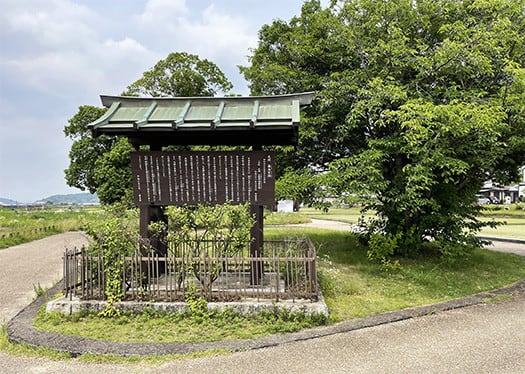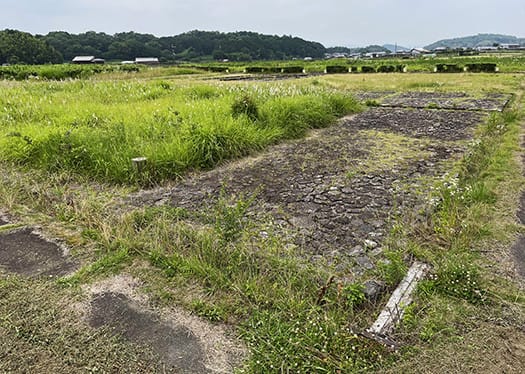

昭和47年に「史跡・伝飛鳥板蓋宮跡」として史跡指定された地域は
平成28年10月に名称が史跡「飛鳥宮跡」と変更された。
日本書紀などでは推古天皇から持統天皇に至る7世紀の約100年間、
歴代天皇の宮が次々と飛鳥の地に造営されたと記されている。
昭和34年以来、橿原考古学研究所の発掘調査が続けられてきた。
宮の中心部分は東西約158m、南北約197mの長方形区画(内郭)で
区画の内側では大規模な掘立柱建物や石敷き広場などを発見。
この銘板の置かれた位置のすぐ左手に内郭北東側の建物の柱配置・井戸を
復元しているものです。
この内郭を囲むように建物や柱列、石組み溝などが営まれていて、
それらを「外郭」と呼んでいます。
内郭の東南側にはエビノコ大殿とされる大規模な掘立柱建物を中心にする
区画が存在することも確認されています。
これらの遺構は斉明天皇の「後飛鳥岡本宮」および天武持統天皇の
「飛鳥浄御原宮」などに相当するものと考えられている。〜以上、銘文より。
のちの藤原京や平城京などは東アジア世界との交流、相克が
激しさを増していった国際情勢を踏まえて、
いかにも都城にふさわしい「都市建設」が意図されていったけれど、
それ以前の王宮とは、天皇の居館を中心にした必要十分な構成。
これまで紹介してきた池工房や飛鳥寺とも指呼の間で数百メートルの位置。
現在、この宮跡に来て見ると周辺は水田地帯が広がっていて
また、当初は石敷きと区割りの石が史跡指定当時は明確だったのが
やがて草深くなってきていると見受けられる。
印象で言えば、非常に素朴な権力機構の遺構と感じられる。
仁徳帝が民の家から煙が上がっていない様子を見て節約に励んだという故事が
素直に受け止め可能なようにも思える。
石で踏み固めた権力痕跡がやがて田んぼになり草に覆われて
いかにも牧歌的な風景に還元されている平和な様子。
こういう風景に佇んでいると、
日本の原初の王権は本来この程度であったものが、
東アジアの超大国・唐が出現したことでそれへの外交対応、独立維持が
この国の権力機構の進展に非常に大きな要因だったとわかる。
現実に半島の動乱の政治・軍事情勢〜白村江戦争の結果、
百済の遺民が大挙日本に帰化して、唐の強大を身を以て知ったかれらが
亡命したこの日本の王権を強化することに必死だった。
そういった歴史の見方に強く同意したくなる。
中国の強権はつねに半島地域に対して剥き出しの暴力性を示し
列島社会はその脅威に備えた対応をしてきたのだと。
その安全保障的行動原理から律令と仏教を積極的に受け入れたという展開。
日本史の底流にこういう国際関係論があったことがわかる。
海を挟んでいることから幸いにして大陸的男系DNA根絶やし大量殺戮からは
歴史的に逃れられてきたとのが歴史の実相なのでしょう。
日本人の「平和意識」というものの原点なのかも知れませんね。
English version⬇
Asuka Palace Site (Itabukinomiya)" Asuka Historical Testimony-9
A land with vigorous natural resilience. The central area of power is quickly reduced to a landscape of rice paddies and grass. It is a landscape of the origin of Japan's pacifism. ...
The area designated as a historic site in 1972 as "Historic Site, Den Asuka Itabukinomiya-gū Ato" was
The name was changed to "Asuka Palace Site" in October, 2008.
According to the Nihon Shoki (Chronicles of Japan) and other records, the palaces of successive emperors were located one after another for about 100 years in the 7th century from Emperor Suiko to Emperor Jito.
The Chronicles of Japan and other documents state that the palaces of successive emperors were built one after another in Asuka during the 100 years of the 7th century from Emperor Suiko to Emperor Jito.
Since 1959, the Archaeological Institute of Kashihara has continued excavations.
The central part of the palace is a rectangular section (inner wall) measuring approximately 158 m east to west and 197 m north to south.
A large dugout pillar building and a stone-paved plaza were found inside the inner wall.
The pillar layout of the building on the northeast side of the inner wall and the well are restored to the immediate left of the location where this nameplate is placed.
This is a restoration of the well and the pillar layout of the building on the northeast side of the inner wall.
The buildings, rows of pillars, and masonry ditches surrounding the inner wall are called the "outer wall.
These are called the "outer wall.
On the southeast side of the inner wall, there is a large hottate-bashira building, which is believed to be the Ebinoko-daiden.
These remains are the remains of the Saimei Tenmangu Shrine.
These remains are related to the "Go-Asuka Okamoto Palace" of Emperor Saimei and the "Asuka Kiyomihara Palace" of Emperor Temmu Mochito.
These remains are thought to correspond to the "Asuka Jomihara Palace" of Emperor Saimei and the "Asuka Jomihara Palace" of Emperor Temmu Jito. 〜The above is from the inscription.
The Fujiwara-kyo and Heijo-kyo Capital later became the center of international
The Fujiwara-kyo and Heijo-kyo Capital were built as "cities" that were suitable for a capital city in light of the international situation
The later Fujiwara-kyo and Heijo-kyo were intended to be "city-builders" that would be suitable for a capital city, but
The royal palaces of the earlier period were composed of a necessary and sufficient structure with the emperor's residence at the center.
It is located within a few hundred meters from Ikegakobo and Asukadera, which we have introduced so far.
When we come to this palace site today, we see that the surrounding area is covered with rice paddies.
In addition, the stone pavement and ward stones were clear at the time of the initial designation as a historic site.
It can be seen that the grass is eventually becoming deeper and deeper.
In terms of impression, it seems to be the remains of a very simple power structure.
The legend that Emperor Nintoku saw no smoke rising from the houses of his people and encouraged them to save money seems to me to be a story that can be accepted honestly.
The traces of power stamped out with stones are still there.
The traces of power trampled with stones eventually turned into rice paddies and covered with grass.
The peaceful scene is reduced to a pastoral landscape.
Standing in such a landscape
I am reminded that Japan's original kingship was originally only this small, and that the Tang Dynasty, the superpower of East Asia, was a great power.
The emergence of the Tang Dynasty, the superpower of East Asia, and its diplomatic response to the Tang Dynasty, as well as the maintenance of independence, were very important in the development of the country's power structure.
The emergence of the Tang Dynasty, the superpower of East Asia, was an extremely important factor in the development of the country's power structure.
In reality, the political and military situation on the peninsula was in turmoil, and as a result of the Baekchon River War
The Baekje people were naturalized in Japan in great numbers, and they learned firsthand of the might of the Tang Dynasty.
They were desperate to strengthen their royal power in exile in Japan.
I am inclined to strongly agree with this view of history.
Chinese power has always shown itself to be openly violent toward the peninsular region, and island societies were prepared for the threat.
The archipelagic societies have responded to this threat.
The security principle of the Japanese government led to its active acceptance of the Ritsuryo Code and Buddhism.
It is clear that this kind of theory of international relations was at the bottom of Japanese history.
Fortunately, the fact that Japan is located on the other side of the sea has historically allowed it to escape the continental eradication of its male DNA and the genocide of its people.
The reality of history is that Japan has historically escaped genocide by eradicating continental male DNA.
This may be the origin of the Japanese sense of peace.










